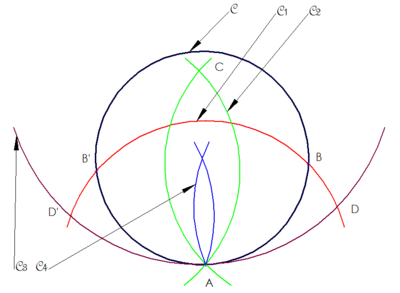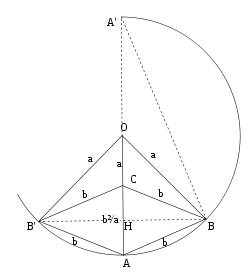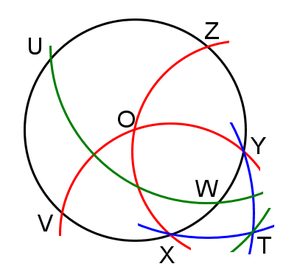- Napoleon's problem
-
Napoleon's problem is a famous compass construction problem. In it, a circle and its center are given. The challenge is to divide the circle into four equal arcs using only a compass. Napoleon was known to be an amateur mathematician but it is not known if he either created or solved the problem. Napoleon's friend the Italian mathematician Lorenzo Mascheroni introduced the limitation of using only a compass (no straight edge) into geometric constructions. But actually, the challenge above is child's play compared to the real Napoleon's problem, consisting in finding the center of a given circle with compass alone. The following sections describe a solution to that one, and the proof it works. Georg Mohr, in 1672, produced a book, "Euclides Danicus", that predated Mascheroni, though the book was only rediscovered in 1928.
Contents
Finding the centre of a given circle
Construction
Let (C) the circle, of which, one wishes to find the centre. Let A a point on (C).
A circle (C1) centered at A meets (C) at B and B'.
Two circles (C2) centered at B and B', with radius AB crosses again at point C.
A circle (C3) centered at C with radius AC meets (C1) at D and D'
Two circles (C4) centered at D and D' with radius AD meet at A, and at the searched-for center of (C).
Note: for this to work the radius of circle (C1) must be neither too small nor too large. More precisely, this radius must be between half and double of the radius of (C).
Proof
The idea behind the proof is to construct, with compass alone, the length b²/a when length a and b are known.
In the figure on the right, triangle ABA' has a right angle at B and BH is perpendicular to AA", so : AH/AB = AB/AA' Therefore AH = b²/(2a) and AC = b²/a
In the construction above figures twice a configuration of this type :
- points A, B and B' are on the circle of centre O, radius r ; AB, AB', BC and B'C are equal to R, so

- points A, D and D' are on the circle of centre C, radius
 , DA, D'A, DX, D'X are equal to R so
, DA, D'A, DX, D'X are equal to R so  .
.
Therefore X is the centre of circle (C)
````Dividing a given circle into four equal arcs given its centre
Centred on any point X on circle C, draw an arc through O (the centre of C) which intersects C at points V and Y. Do the same centred on Y through O, intersecting C at X and Z. Note that the distances OV, OX, OY, OZ, VX, XY, YZ are all the radius of the circle C.
Now draw an arc centred on V which goes through Y and an arc centred on Z which goes through X; call where these two arcs intersect T. Note that the distances VY and XZ are
 times the radius of the circle C.
times the radius of the circle C.Put the compass radius equal to the distance OT (
 times the radius of the circle C) and draw an arc centred on Z which intersects the circle C at U and W. UVWZ is a square and the arcs of C UV, VW, WZ, and ZU are each equal to a quarter of the circumference of C.
times the radius of the circle C) and draw an arc centred on Z which intersects the circle C at U and W. UVWZ is a square and the arcs of C UV, VW, WZ, and ZU are each equal to a quarter of the circumference of C.See also
Categories:- Euclidean plane geometry
- Mathematical problems
- Napoleon
- points A, B and B' are on the circle of centre O, radius r ; AB, AB', BC and B'C are equal to R, so
Wikimedia Foundation. 2010.



